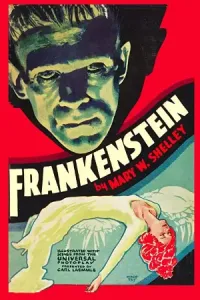"It's Alive!": How James Whale's 'Frankenstein' Electrified Horror and Created a Monster for the Ages!
In the annals of cinematic history, few films cast a shadow as long and as influential as James Whale's Frankenstein (1931). More than just a horror movie, it is a foundational pillar of the genre, a masterpiece that not only terrified audiences upon its release but also codified many of the tropes and visual aesthetics that would define monster cinema for decades to come. Released by Universal Pictures, hot on the heels of their success with Dracula (1931), Frankenstein cemented the studio's reputation as the undisputed home of classic monsters and firmly established the "horror cycle" of the 1930s. Its portrayal of the Monster, a lumbering, misunderstood behemoth brought to life through scientific hubris, became the indelible image in the public consciousness, often mistakenly conflated with his creator, Dr. Frankenstein himself. This film's groundbreaking makeup, iconic set design, and masterful blend of gothic dread with philosophical underpinnings ensured its status as a timeless classic, demonstrating the power of horror to delve into profound questions about life, death, humanity, and the dangerous pursuit of forbidden knowledge.
The film plunges audiences into the chilling world of Henry Frankenstein (Colin Clive), a brilliant but obsessed scientist driven by an unholy ambition to unlock the secrets of life itself. Abandoning his fiancée and studies, he retreats to a remote laboratory, where, amidst crackling electricity and bubbling chemicals, he stitches together a new being from cadaverous parts. Whale's direction is a marvel, utilizing stark, expressionistic lighting and dynamic camera angles to create an atmosphere of palpable tension and dread. The iconic moment of the Monster's awakening, charged with lightning and the guttural cry of "It's alive!", remains one of cinema's most electrifying scenes. Beyond the shock, the film delves into the tragic plight of the Monster (Boris Karloff), who, through no fault of his own, is feared and persecuted by a world that cannot comprehend his existence. This tragic core elevates Frankenstein beyond mere frights, transforming it into a poignant commentary on prejudice and the consequences of creations unleashed without responsibility.
The enduring power of Frankenstein owes much to its unforgettable performances, particularly that of Boris Karloff as the Monster. Despite having no dialogue, Karloff conveys a heartbreaking blend of innocence, confusion, and growing rage through his expressive eyes and lumbering physicality, creating a sympathetic figure even as he commits terrible acts. Colin Clive is equally compelling as the tormented Dr. Frankenstein, embodying the manic energy of a man consumed by his own forbidden genius. They are ably supported by Mae Clarke as Elizabeth and Dwight Frye as the chilling, hunchbacked assistant Fritz. Frankenstein was a massive box office success and was heavily praised for its technical achievements, including the groundbreaking makeup designed by Jack Pierce, which transformed Karloff into the unforgettable creature. The film was so impactful that it spawned numerous sequels and parodies, solidifying its place not just as a horror classic, but as a cultural touchstone that continues to inspire and terrify generations.
Director: James Whale.
Cast: Boris Karloff as The Monster, Colin Clive as Henry Frankenstein, Mae Clarke as Elizabeth, John Boles as Victor Moritz, and Dwight Frye as Fritz.
Special Info/Trivia: The iconic Monster makeup was created by Jack Pierce, and it took four hours to apply daily. The film's famous line "It's alive!" was initially censored due to production code restrictions but later restored. The scene where the Monster tosses a young girl into a lake was heavily cut due to its disturbing nature in early releases but has been restored in later versions. The film was based on Mary Shelley's 1818 novel, though it took many liberties, including famously naming the creature "Frankenstein" in popular culture, despite the novel referring to the scientist by that name.

